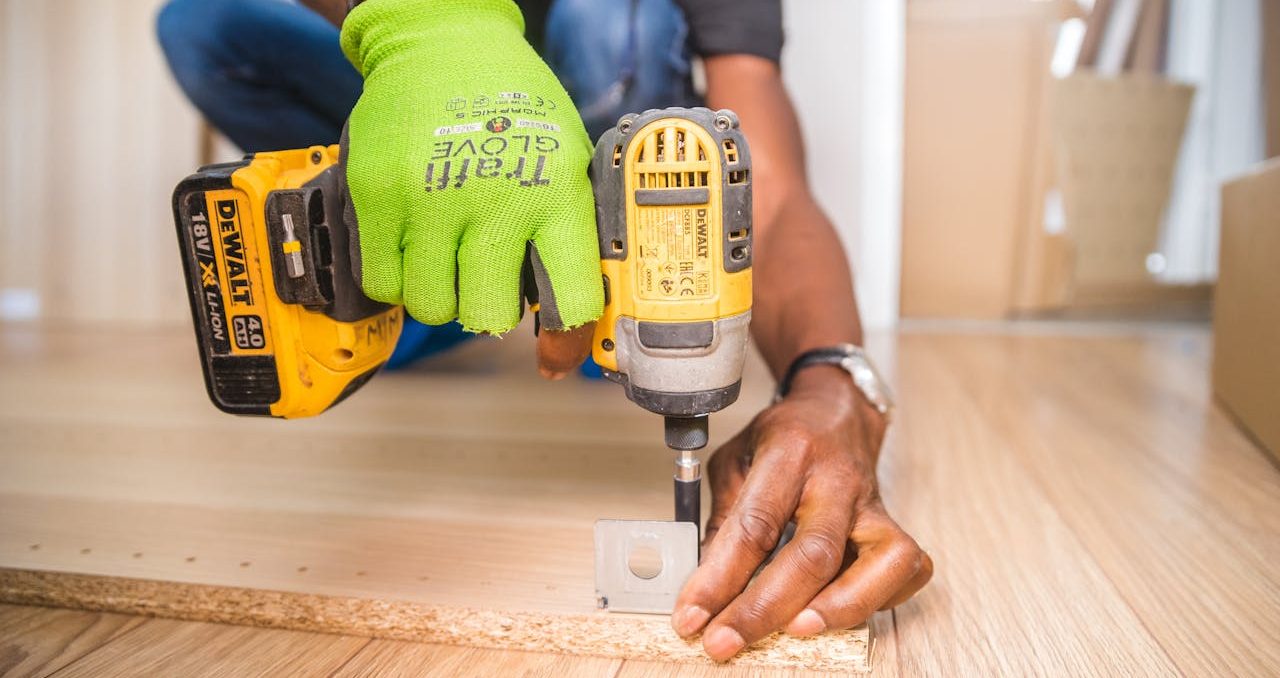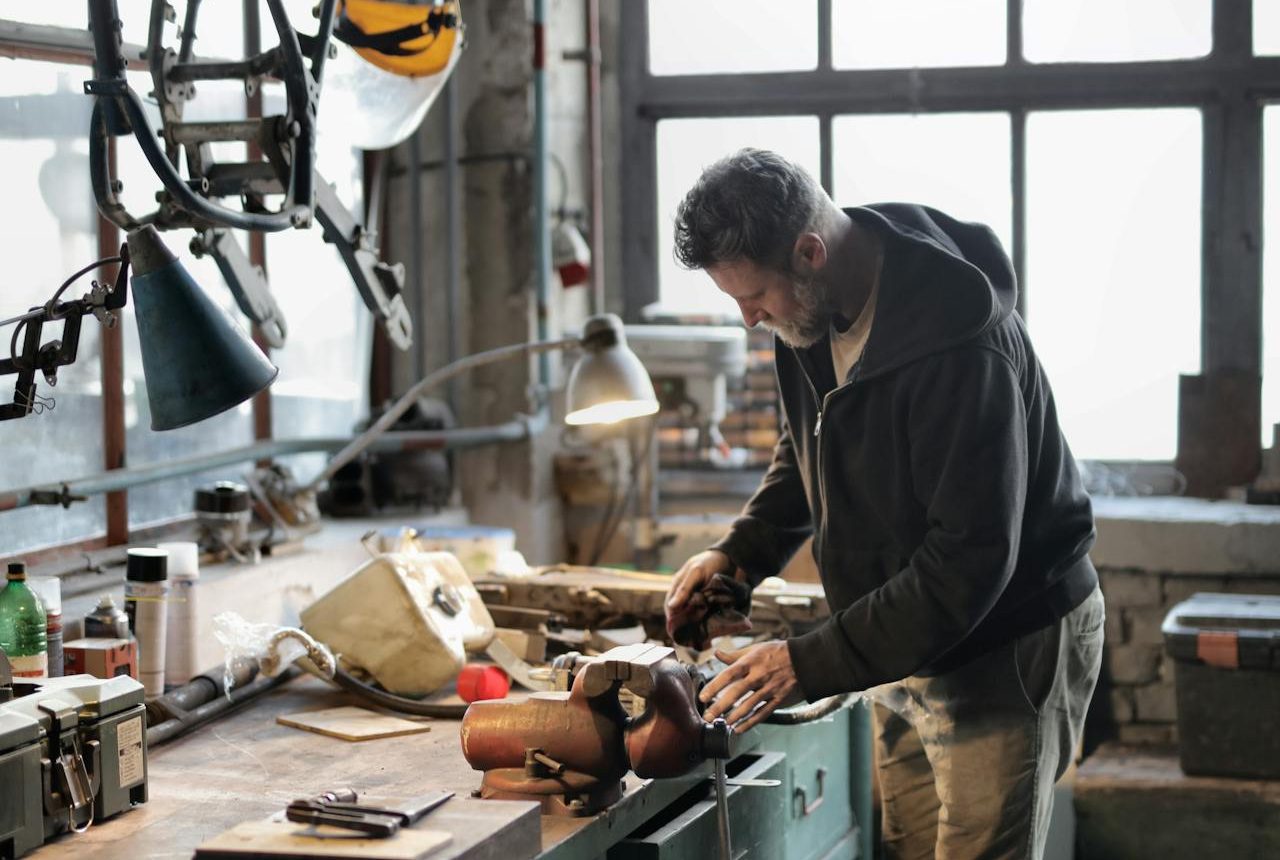Choosing the right floor for your campervan conversion means considering several factors to ensure it meets your needs and preferences.
In this blog, we’ll look at the different types of flooring available to campervan converters, whether you need to install a floor in your campervan, subfloors and top floors, and where to buy your flooring.
How to choose the right flooring for your campervan

Before you buy any flooring there are certain factors you need to consider. Get the pen and notepad out and jot down your ideas as you go through our guide.
Define your requirements
Consider how you plan to use your campervan. Are you looking for durability, insulation, ease of maintenance, or aesthetics? Think about your priorities to narrow down your options.
Consider weight
Campervans have weight limits, so choose lightweight flooring to avoid exceeding these limits. Look for materials like vinyl or lightweight laminate that offer durability without adding too much weight.
DVLA requirements for van conversions: How to make your van road legal
Check insulation needs
If you’re converting your campervan for all-season use, consider the insulation properties of the flooring. Some materials, like rubber or cork, provide better insulation than others, helping to keep your van warm in colder months.
Assess water resistance
Campervans are prone to moisture buildup, especially in wet climates or during outdoor activities. Choose flooring materials that are waterproof or water-resistant to prevent damage and mould growth. Vinyl, rubber, and certain laminates are good options for water resistance.
Think about maintenance
Consider how much maintenance different flooring options require. Some materials, like vinyl and laminate, are easy to clean and maintain, while others, like carpet, may require more effort.
Factor in aesthetics
Your campervan’s flooring contributes to its look and feel. Choose a flooring material and design that complements your interior style and personal preferences. Consider factors like colour, pattern, and texture.
Budget considerations
Determine your budget for flooring and prioritise features based on your budget constraints. While some materials may be more expensive upfront, they could save you money in the long run due to their durability and low maintenance requirements.
Test samples
Obtain samples of different flooring materials to see how they look and feel in your campervan. This will give you a better idea of how each material will perform in your space.
Research installation requirements
Consider the installation process for each flooring option and whether you’re comfortable tackling it yourself or prefer to hire a professional. Some materials may require special tools or techniques for installation.
Read reviews and seek recommendations
Research reviews and seek recommendations from other campervan owners or conversion specialists to learn about their experiences with different flooring materials. This can help you make an informed decision based on real-world feedback.
By following these steps and considering your specific needs and preferences, you can choose the flooring for your campervan conversion that enhances functionality and aesthetics.
What’s the difference between a subfloor and a top floor?

In the context of a campervan conversion or any construction project, the terms ‘subfloor’ and ‘top floor’ refer to different layers of flooring materials, each serving distinct purposes. Here’s a breakdown of the differences between a subfloor and a top floor:
Subfloor
Location
The subfloor is the bottom layer of the flooring, typically installed directly on the structural frame or base of the vehicle (e.g. metal chassis in the case of a campervan).
Purpose
The primary function of the subfloor is to provide a level and stable surface for installing the top floor. It acts as a foundation that supports the weight of the top floor and provides structural integrity to the flooring system.
Materials
Subfloor materials are chosen for their strength, durability, and suitability for the application. Common subfloor materials include plywood, oriented strand board (OSB), or metal sheeting, depending on the construction requirements and preferences. Some vans may already have suitable subfloor, so check when you buy your van.
Insulation and moisture barrier
In addition to providing a base for the top floor, the subfloor may also incorporate insulation materials and moisture barriers to enhance thermal efficiency and prevent moisture-related issues such as condensation or water damage.
Top floor
Location
The top floor is the visible layer of flooring installed on top of the subfloor, serving as the walking surface inside the campervan.
Purpose
The top floor serves both functional and aesthetic purposes. It provides a comfortable and durable surface for occupants to walk on while contributing to the ambience.
Materials
Top floor materials vary depending on personal preference, budget, and desired characteristics. Common options include vinyl flooring, laminate flooring, carpet tiles, rubber flooring, hardwood flooring, linoleum, and cork flooring.
Design and appearance
The top floor is visible and influences the look and feel of the interior space. Therefore, it is often chosen based on factors such as colour, texture, pattern, and style to achieve the desired aesthetic.
In summary, the subfloor provides structural support and a foundation for the top floor. The top floor is the visible layer of flooring that contributes to the functionality and appearance of the interior space in a campervan or any construction project.
Campervan floor layout guide: importance, layout types and how to design a floor plan
Do I need to install a subfloor in my campervan?

Whether you need to install a subfloor in your campervan depends on various factors, including your specific needs, preferences, and the existing condition of the vehicle. Here are some considerations to help you decide:
Base condition
If your campervan has a solid and level base, such as a metal chassis or a sturdy existing floor, you may not need to install a separate subfloor. In such cases, you can install the top flooring material on the existing surface after ensuring it’s prepared and suitable for the chosen flooring option.
Structural support
A subfloor provides structural support and stability for the top flooring material. If the existing base of your campervan lacks sufficient structural integrity or is uneven, installing a subfloor can help create a stable foundation for the top floor and ensure a level surface.
Insulation
A subfloor can also serve as a layer of insulation, helping to regulate temperature and reduce heat loss or gain within the campervan. If you prioritise thermal efficiency and comfort, especially in varying weather conditions, installing a subfloor with insulation materials may be beneficial.
Moisture protection
In some cases, a subfloor can act as a barrier against moisture, preventing water from seeping into the interior of the campervan and causing damage to the flooring materials. This is particularly important if your campervan is prone to moisture issues or if you plan to travel in wet climates.
Flooring material compatibility
Consider the compatibility of your chosen flooring material with the existing base of your campervan. Some flooring options may require a specific type of subfloor or preparation to ensure proper installation and long-term performance.
Ultimately, deciding to install a subfloor in your campervan depends on your specific requirements and the vehicle’s condition.
It’s essential to assess the structural integrity, insulation needs, and compatibility with your chosen flooring material before installing.
If you’re unsure or need guidance, consulting with a professional camper van conversion specialist can help you decide based on your unique circumstances.
What are the different flooring options for campervans?

Vinyl flooring
Vinyl flooring is popular for campervans due to its durability, water resistance, and easy maintenance. It’s available in various styles and designs, including wood and tile patterns. Vinyl is lightweight and affordable, making it suitable for camper van conversions.
Pros:
- Waterproof: Resistant to water and moisture, making it suitable for campervans where spills or humidity might occur.
- Easy to clean: Wipe-clean surface makes maintenance simple.
- Durable: Can withstand heavy foot traffic and is scratch and stain resistant.
- Lightweight: Doesn’t add much weight to your campervan.
Cons:
- Limited insulation: provides minimal insulation compared to other options.
- Limited aesthetic options: While available in various designs but may not offer as much customisation as other materials.
Laminate flooring
Laminate flooring is another popular option known for its durability and aesthetic appeal. It consists of a synthetic layered construction that mimics the look of wood or tile. Laminate flooring is easy to clean and install, making it suitable for DIY campervan projects.
Pros:
- Durable: Resistant to scratches, stains, and wear, making it suitable for high-traffic areas.
- Easy to clean: Requires minimal maintenance and can be cleaned with a damp cloth.
- Aesthetic variety: Available in a range of colours, patterns, and finishes to suit different interior styles.
Cons:
- Water sensitivity: Susceptible to water damage if exposed to moisture for extended periods, so proper sealing is essential.
- Weight: Slightly heavier than vinyl, which may be a concern for weight-conscious conversions.
Carpet tiles
Carpet tiles offer a soft and comfortable flooring option for campervans. They come in various colours and patterns, allowing for interior space customisation. Carpet tiles are easy to install and replace, making them a practical choice for camper van conversions.
Pros:
- Soft and comfortable: Provides a cosy feel underfoot, making it ideal for cold climates.
- Insulating: Offers better insulation properties compared to hard flooring options, helping to retain heat.
- Easy to replace: Individual tiles can be replaced if damaged, offering convenience and cost-effectiveness.
Cons:
- Prone to staining: Spills and stains may be more challenging to clean compared to hard flooring surfaces.
- Retains moisture: Can absorb moisture odours if not properly maintained, which can lead to mould or mildew growth.
Rubber flooring
Rubber flooring is a durable and resilient option for campervans, providing excellent traction and impact resistance. It’s waterproof and easy to clean, making it suitable for outdoor and adventure-oriented conversions. Rubber flooring is available in rolls or tiles and comes in various colours and textures.
Pros:
- Waterproof: Resistant to water and moisture, making it suitable for wet environments.
- Durable: Withstands heavy use and is scratch, stain and abrasion resistant.
- Insulating: Provides some thermal insulation and sound-dampening properties.
Cons:
- Limited aesthetic options: Typically available in a limited range of colours and patterns.
- Initial odour: May emit a rubber odour initially, which dissipates over time.
Cork flooring
Cork flooring is an eco-friendly option made from the bark of cork oak trees. It’s naturally resistant to mould, mildew, and pests, making it ideal for campervans. Cork flooring provides excellent insulation and cushioning, creating a comfortable and quiet interior environment.
Pros:
- Sustainable: Made from renewable cork material, making it an eco-friendly choice.
- Insulating: Provides natural thermal and sound insulation properties.
- Comfortable: Offers a soft and comfortable surface to walk on.
Cons:
- Susceptible to damage: Can be damaged by sharp objects or heavy furniture if not properly protected.
- Requires sealing: Needs to be sealed to prevent water damage, especially in moisture-prone areas like bathrooms or kitchens.
Hardwood flooring
Hardwood flooring adds a touch of elegance and warmth to campervan interiors. While it’s less common due to its weight and cost, hardwood flooring offers durability and timeless appeal. Engineered hardwood or bamboo flooring may be more suitable for camper van conversions due to their lighter weight and better moisture resistance.
Pros:
- Durability: Hardwood flooring is known for its durability and can withstand heavy foot traffic and wear over time, making it suitable for campervans.
- Aesthetic appeal: Hardwood flooring adds a touch of elegance and warmth to the interior of the campervan, enhancing its look and feel.
- Longevity: With proper maintenance, hardwood flooring can last decades, providing long-term value for your campervan conversion.
- Easy maintenance: Hardwood flooring is easy to clean and maintain, requiring regular sweeping and occasional mopping with a wood-friendly cleaner.
- Resale value: Installing hardwood flooring in your campervan may increase its resale value, as it’s a desirable feature for many buyers.
Cons:
- Weight: Hardwood flooring is heavier than many other flooring options, which may be a concern for campervans with weight restrictions or those aiming to maximise fuel efficiency.
- Cost: Hardwood flooring can be more expensive upfront compared to other flooring materials, potentially increasing the cost of your campervan conversion project.
- Vulnerability to moisture: Hardwood flooring is susceptible to damage from moisture, making it less suitable for environments prone to spills or high humidity levels. Proper sealing and maintenance are necessary to prevent water damage.
- Maintenance requirements: While easy to maintain, hardwood flooring may require periodic refinishing or resealing to keep it looking its best, which can be time-consuming and costly.
- Environmental considerations: Depending on the source and manufacturing process, hardwood flooring may raise environmental concerns related to deforestation and chemical use. Opting for sustainably sourced hardwood or alternative eco-friendly materials may mitigate these issues.
Linoleum flooring
Linoleum flooring is a natural and eco-friendly option made from linseed oil, wood flour, cork dust, and other renewable materials. It’s durable, water-resistant, and easy to clean, making it suitable for campervans. Linoleum comes in various colours and patterns, allowing for creative customisation of the interior space.
Pros:
- Durability: Resistant to heavy foot traffic and wear, making it suitable for campervan interiors.
- Water resistance: Naturally resistant to water and moisture, ideal for environments prone to spills or humidity.
- Easy maintenance: Simple to clean and maintain with regular sweeping and mopping.
- Eco-friendly: Made from natural and renewable materials, offering an environmentally-friendly flooring option.
- Comfortable underfoot: Provides a slightly cushioned feel, enhancing comfort for occupants.
- Variety of designs: Available in various colours, patterns, and styles for customisation.
Cons:
- Susceptible to scratches and dents: Can be scratched or dented by sharp objects or heavy furniture.
- Installation complexity: Requires careful preparation of the subfloor and adhesive application for proper installation.
- Higher initial cost: May have a higher upfront cost compared to some other flooring options.
- Limited insulation: Provides some insulation but may not offer as much thermal or sound insulation as thicker materials.
- Vulnerability to moisture damage: While resistant to water, it can still be damaged by prolonged exposure to moisture if not properly sealed or maintained.
Each flooring option has pros and cons, so it’s important to choose the one that best suits your needs, preferences, and budget for your campervan conversion project.
Can I install heated flooring in my campervan?

Yes, you can install heated flooring in your campervan, although there are some considerations to keep in mind:
Power source
Heated flooring systems typically require electricity to operate. Ensure that your campervan’s electrical system can handle the additional load of the heated flooring without overloading the circuit or draining the battery excessively. You may need to upgrade your electrical system or install a separate circuit for the heated flooring.
Insulation
Proper insulation is essential when installing heated flooring in a campervan. Without adequate insulation, heat may escape through the floor, reducing the efficiency of the system and wasting energy. Consider adding insulation layers beneath the heated flooring to improve thermal efficiency and retain heat inside the van.
Flooring material compatibility
Not all flooring materials are suitable for use with heated flooring systems. Before installing heated flooring, ensure that the flooring material you choose is compatible with radiant heat and won’t be damaged by the elevated temperatures generated by the system. Ask the flooring material manufacturer if it’s compatible with heated flooring.
Installation considerations
Installing heated flooring in a campervan may require careful planning and professional installation, especially if it involves embedding heating elements within the floor or connecting the system to the electrical supply. Ensure the installation process is carried out correctly to prevent any safety hazards or damage to the van.
Control options
Consider how you will control the heated flooring system in your campervan. Some systems come with thermostats or temperature controls that allow you to adjust the heat output as needed. Choose a control option that suits your preferences and provides convenient access to regulate the temperature inside the van.
While it is possible to install heated flooring in a campervan, it’s essential to consider factors such as power source, insulation, flooring material compatibility, installation requirements, and control options to ensure a safe and efficient heating solution for your van.
Consulting with a professional installer or heating specialist can help you determine the best approach for your specific needs and preferences
When should I install the flooring in my campervan?

The timing for installing the floor in your campervan depends on various factors, including the progression of your conversion project and personal preferences.
There’s no ‘set time’ as such, but there are some jobs that you should complete before the flooring goes in. Here are some considerations to help you decide when to install the floor:
Construction sequence
The floor installation typically occurs after completing certain foundational aspects of the campervan conversion, such as insulation, electrical wiring, and any necessary structural modifications. Installing the floor at the appropriate stage ensures it remains intact and undamaged during subsequent construction tasks.
Accessibility
Consider the ease of access to the interior space of your campervan during the construction process. Installing the floor earlier in the conversion allows for better accessibility to the floor area and facilitates other tasks, such as installing cabinetry, furnishings, and fixtures.
Flooring material compatibility
Certain flooring materials may have specific installation requirements or recommendations regarding timing. Follow the manufacturer’s instructions and guidelines for the optimal timing of floor installation based on the selected flooring material.
Protection from damage
Installing the floor earlier in the conversion process can help protect it from potential damage caused by construction activities, such as spills, debris, or accidental impacts. However, consider covering or protecting the installed floor during subsequent construction tasks to prevent damage.
Integration with other components
Coordinate the timing of floor installation with other components of the campervan, such as cabinetry, appliances, and furnishings. Ensuring proper alignment and integration of these elements may influence the timing of floor installation.
Climate and weather conditions
If working in an outdoor environment or areas with fluctuating weather conditions consider the impact of temperature, humidity, and precipitation on the floor installation process. Choose appropriate weather conditions for installing the floor to ensure optimal adhesion, sealing, and drying of materials.
Personal timeline
Consider your timeline and schedule for completing the campervan conversion. Plan the floor installation based on your availability, resources, and desired completion date for the project.
In summary, the floor installation in your campervan should be timed appropriately within the conversion process, considering factors such as construction sequence, accessibility, flooring material compatibility, protection from damage, integration with other components, climate conditions, and personal timeline.
By carefully planning and coordinating the timing of floor installation, you can ensure a successful and efficient conversion of your campervan.
Where to buy campervan flooring in the UK

In the UK, you can buy campervan flooring from various retailers, both online and offline. Here are some options:
Speciality campervan conversion retailers
Several retailers specialize in campervan conversion supplies and accessories in the UK. These stores often carry a range of flooring options suitable for campervans. Examples include Kiravans, Camperco, and VanPimps.
DIY stores
Visit popular DIY stores such as B&Q, Wickes, or Homebase. They typically stock a variety of flooring materials suitable for campervan conversions, including vinyl, laminate, and carpet tiles.
Online retailers
Explore online marketplaces like Amazon UK, eBay UK, or specialist campervan conversion websites. These platforms offer a wide selection of flooring materials, often with customer reviews and competitive pricing.
RV dealers and suppliers
RV dealerships and suppliers in the UK may carry flooring options suitable for campervans. Visit or contact local dealerships to inquire about available products or recommendations for campervan flooring.
Flooring manufacturers
Contacting flooring manufacturers or visiting their websites can provide access to a comprehensive range of flooring options. Some manufacturers may offer online purchasing or provide information on local distributors in the UK.
Local flooring stores
Visit local flooring stores in your area to explore their selection of flooring materials. While primarily catering to residential or commercial applications, some stores may carry suitable options for campervan conversions.
Secondhand or salvage yards
Consider checking secondhand or salvage yards for discounted or reclaimed flooring materials. You may find unique options at a lower cost, though availability and conditions may vary.
Before purchasing campervan flooring, ensure that you have accurate measurements of your van’s interior space and consider factors such as material durability, ease of installation, maintenance requirements, and compatibility with your conversion design. Additionally, compare prices, warranties, and customer reviews to make an informed decision.
Should I install campervan flooring myself or hire a professional?

Whether to install campervan flooring yourself or hire a professional depends on several factors, including your DIY skills, experience, time availability, budget, and the complexity of the installation. Here are some considerations to help you decide:
Installing campervan flooring yourself
- DIY skills: If you have experience with DIY projects and feel confident in your skills, installing campervan flooring yourself can be a rewarding and cost-effective option.
- Budget: DIY installation can help you save money on labour costs, as you won’t have to pay for professional installation services. However, consider the cost of materials, tools, and any potential mistakes or rework.
- Flexibility: Installing flooring yourself gives you greater flexibility and control over the project timeline and design choices. You can work at your own pace and make adjustments as needed without relying on a contractor’s schedule.
- Learning experience: DIY installation allows you to learn new skills and gain a deeper understanding of your campervan’s construction and systems. It can be a fulfilling and educational experience if you enjoy hands-on projects.
Hiring a professional
- Complexity: If the campervan flooring installation requires specialised tools, techniques, or expertise, hiring a professional may ensure a high-quality result. Complex installations, such as heating systems or intricate patterns, may benefit from professional knowledge and experience.
- Time constraints: If you have limited time available or prefer to expedite the project, hiring a professional can save you time and effort. Professionals have the experience and resources to complete the installation efficiently and effectively.
- Quality assurance: Professional installers have the skills and training to achieve precise measurements, proper alignment, and seamless finishes. They can ensure that the flooring is installed correctly and meets industry standards for safety and durability.
- Warranty and guarantee: Many professional installers offer warranties or guarantees on their workmanship, providing peace of mind in case of any issues or defects. This additional protection may be worth the investment, especially for more complex or expensive flooring materials.
Ultimately, deciding to install campervan flooring yourself or hire a professional depends on your circumstances, preferences, and priorities.
Consider your skills, budget, timeline, and the complexity of the installation, and choose the option that best aligns with your needs and goals for your campervan conversion project.
If you’re unsure, you can always consult a professional for advice or assistance with specific aspects of the installation.
Talk to us about your campervan conversion
If you need more information on how to convert your dream campervan, visit our enquiries page and we’ll provide all the knowledge and support you need to begin.

